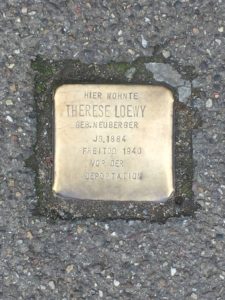It happened frequently when we embarked on a leisurely walk through picturesque Freiburg im Breisgau, where my family and I lived for much of 2016. At some point my children (then ages ten and seven) or my husband and I would stop abruptly and bend forward deeply to decipher the writing etched on a brass plate ensconced on a small, cobble-stone sized concrete cube in the middle of the sidewalk or square. Everyone else had to wait as well, if sometimes grudgingly – which is exactly what these so-called Stolpersteine (literally translated as stumbling blocks) are meant to do.
Since the German artist Gunter Demnig conceived of them in 1993 as memorials for the victims of National Socialism, his ongoing project has led to the installation of more than 50,000 Stolpersteine all over Europe, making it the world’s largest memorial. No end is in sight: according to their website there is a long waiting list for future Stolpersteine.
One of these Stolpersteine was close to the Freiburg Institute for Advanced Studies, where my husband was researching at the time, so we passed it many times:

“Here lived Therese Loewy, maiden name Neuberger,” it read. “Born 1884, suicide before deportation in 1940.”
Therese Loewy was born in Munich. She had followed her husband Alfred Loewy to Freiburg, where the renowned mathematician taught as a professor at the famous university. Alfred, who had been blind on one eye since 1916, lost his eyesight almost completely in 1928, but never cancelled a single class because of it. When the Nazis came to power in 1933, he was immediately forced to retire. He died two years later, and his wife Therese visited his grave almost daily. It was located in Freiburg’s Jewish cemetery, next to the grave of their deceased child.
In 1940, Therese was given two hours notice to pack a suitcase before being deported to the internment camp Gurs in Vichy France. When the Gestapo arrived at Therese Loewy’s doorstep, she had already slit her wrists instead of following the orders. The Gestapo immediately confiscated her fortune. Most of the some four hundred Jews from Freiburg deported that day were later killed in Auschwitz.
Today ordinary Germans reside in many of the apartments where people like Therese Loewy and others with similar fates used to live. Each of the Stolpersteine is a tiny memorial. It may not even be a “dignified” memorial (yes, countless people don’t stop to look at them and, in fact, carelessly step on them all the time). But many others stumble upon – and on – them. They stop and read and think. Children ask about them. Parents start talking. Sometimes people try to find out more about the people they mention.
Watching the ongoing debate in the United States about confederate memorials, which really should be a larger debate about the proper way that that country can come to terms with its own racist past, I often have to think of Germany’s Stolpersteine.
What if while walking through towns and cities all over the United States, one were to stumble across blocks commemorating the violent injustices committed by whites against black and brown people during the history of that country?
What if many people were to stumble and be compelled to stop and read and think?
What if children were to stumble and, as a result, ask about the institution of slavery?
What if parents were to stumble and start talking about the terror unleashed against African-Americans after the Civil War – often in the form of lynching?
What if some people were to stumble and then try to find out more about police killings of black men, women, and children?
No, of course, that would not solve the question of what to do with the confederate monuments now standing throughout the US. But it would certainly set an important counterpoint and show that more people in American society are trying to come to terms with this violent and racist history.
After all, the debate about the removal of the confederate monuments is not an attempt to erase history. It also should not lead to pretending that a glorification and romanticizing of the Confederacy has never happened. As George Orwell famously wrote, “Who controls the past controls the future. Who controls the present controls the past.” It was precisely because white privilege continued uninterrupted in this country that these statues were erected in the first place and then upheld in high esteem by many whites – in some cases, still today, as the recent events in Charlottesville and elsewhere clearly suggest. But the past should never be controlled. It should be confronted. It should be struggled with. It should be lived with. Then, maybe, hopefully, lessons can be taken from it.
Thank you, Don. Yes, sobering indeed!
Excellent, Sylvia. What a powerful project for confronting the past and recognizing the significance of the literal spaces, public and private, that we traverse and occupy every day. Sobering to think of how this would look in the US.
Thank you! And feel free to spread the word…;)
Beautifully said!